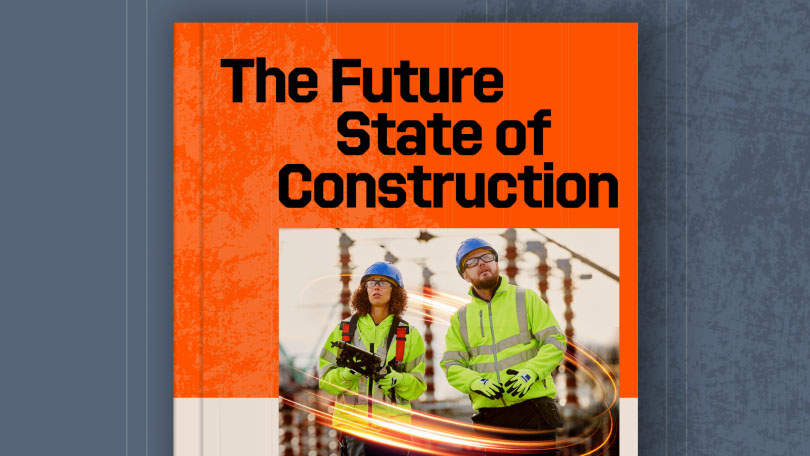— 8 min read
Understanding UK Construction Project Types

Last Updated Nov 25, 2025

Grace Tame
Senior Strategic Product Consultant
Grace is a Senior Strategic Product Consultant at Procore. She helps construction companies improve their quality and safety management by using technology throughout project lifecycle. She is also passionate about the environment and encourages sustainable construction practices. Grace has over 10 years of experience in the construction industry, with roles in: - Bid management - Pre-construction - Construction, as a project engineer and in design management - Handover (including DLP) - Tenancy coordination - Sustainability She has worked on various types of construction projects including Residential, Education, Health, Commercial, Retail, and Public Works. Additionally, she has experience in managing ISO re-accreditation.

Nicholas Dunbar
Content Manager
62 articles
Nick Dunbar oversees the creation and management of UK and Ireland educational content at Procore. Previously, he worked as a sustainability writer at the Building Research Establishment and served as a sustainability consultant within the built environment sector. Nick holds degrees in industrial sustainability and environmental sciences and lives in Camden, London.

Zoe Mullan
27 articles
Zoe Mullan is an experienced content writer and editor with a background in marketing and communications in the e-learning sector. Zoe holds an MA in English Literature and History from the University of Glasgow and a PGDip in Journalism from the University of Strathclyde and lives in Northern Ireland.
Last Updated Nov 25, 2025

The UK's construction industry contributes significantly to the nation's economy. It encompasses a wide range of activities, from constructing detached houses to large-scale infrastructure such as High Speed 2 and the Thames Tideway Tunnel. Understanding the different types of construction projects is crucial for effective project management, risk assessment and compliance with Building Regulations 2010 (their devolved equivalents). This article explores the main construction types in the UK.
Table of contents
Defining Construction Categories
Construction professionals generally categorise projects as:
- Residential
- Commercial & Infrastructure
- Civil
- Industrial, and;
- Institutional
Mixed-use developments blend two or more of these types within a single project.
Categorising construction projects by type matters because it helps define the specific requirements, challenges and risks associated with each category. Different construction types require different skill sets, materials, equipment and safety procedures. By understanding these differences, construction professionals can better plan, execute and manage projects, ensuring safety, compliance and financial success.
Residential Construction
Residential construction involves the building, assembly and renovation of housing structures. This category includes a wide range of projects, from single-family homes (detached houses) to purpose-built flats and high-rise apartment buildings. Garages, outbuildings and extensions also fall within this category.
Main contractors typically oversee all construction stages on residential projects. They may hire subcontractors for specialised trades such as electrical, mechanical and structural work. The project's scale and complexity determine the size of the construction team and the number of architects and construction engineers involved who typically coordinate the design stages according to the RIBA Plan of Work. For example, a single-storey home may require only one architect, while a large build-to-rent complex may need an entire architecture practice.
Under the Construction (Design and Management) Regulations (CDM) 2015, every UK residential project with more than one contractor must appoint a Principal Designer and Principal Contractor to plan, manage and monitor health and safety throughout the project life cycle.
Commercial & Infrastructure Construction
Commercial and infrastructure construction covers the building, assembly and renovation of structures intended for commercial or public use. This category includes a wide variety of projects, such as:
- Shopping centres and retail parks
- Sports arenas and stadiums
- Office buildings
Private companies, individuals or government agencies fund these projects. Government funding commonly supports projects such as stadiums, schools and hospitals.
Like residential construction, commercial and institutional projects often involve construction companies that contract subcontractors for specialised trades. Architects and engineers design these structures, and specialists may contribute to ensure that the building functions properly for its intended purpose.
A major difference between residential and commercial construction centres on the sharp increase in financial risk. Project owners in the commercial space almost certainly need planning permission from a local authority to proceed – without statuatory consent, they are unlikely to qualify for the financing they need to fund the project.
Civil Construction
Civil construction focuses on developing and maintaining essential public infrastructure – often referred to in the UK as 'heavy civil' or simply 'infrastructure.' This category includes projects that facilitate the transportation of people, goods, resources and information, such as:
- Roads, bridges and tunnels
- Railways, including Underground lines, metro systems and tramways
- Airports
- Water supply systems, including reservoirs, pipelines and aqueducts
- Waste-management systems, including drainage
- Communication channels, including telecommunications infrastructure
- Power channels, including electricity grids
These projects often operate on a large scale with significant complexity, requiring specialised engineering expertise and heavy equipment. Government agencies or large private corporations typically fund them, often in the public interest.
Civil infrastructure projects play a crucial role in economic growth and social cohesion. They demand a high degree of planning, design and construction expertise, and regulators subject them to stringent safety and functionality requirements.
Industrial Construction
Industrial construction involves the building, assembly and renovation of structures used for industrial purposes. This includes projects such as:
- Manufacturing plants
- Warehouses
- Power stations
- Oil refineries
- Solar farms
- Hydroelectric facilities
For-profit or industrial corporations typically fund these projects. Industrial construction projects require specialised technical skills throughout the planning, design and construction stages.
This construction type often requires specialised construction companies and skilled tradespeople, with engineers playing a key role in designing functional structures. Electrical, civil and mechanical engineers collaborate to ensure the safe and efficient operation of industrial facilities. As capital expenditure frequently exceeds £100 million, owners and contractors face elevated environmental and process-safety risks compared with residential builds.
Institutional Construction
Institutional construction delivers facilities intended for public service, such as NHS hospitals, academies, universities, museums and courts. Although many institutional projects receive public funding, private entities develop or operate some. These schemes share design and compliance requirements with commercial projects, but public-procurement rules and, often, stricter sustainability targets govern them – for example, BREEAM "Excellent" ratings on new teaching blocks.
Institutional builds may span several phases across occupied sites, requiring meticulous stakeholder management and adherence to safeguarding protocols. Cost ranges vary dramatically: a regional health centre refurbishment might run to £10 million, while a flagship university research laboratory can exceed £250 million.
Understanding Building Regulations 2010
The Building Regulations 2010 – and their devolved equivalents in Scotland and Northern Ireland – set minimum UK standards for structural safety, fire protection, accessibility and energy performance. For higher-risk residential buildings, the Building Safety Act 2022 adds further approval gateways and oversight by the Building Safety Regulator.
All building projects must comply with these regulations, irrespective of their type or end use, and local authority building control bodies or approved inspectors enforce them. Key focus areas include:
Fire Safety
Approved Document B (Part B) outlines fire resistance requirements, detection systems and evacuation procedures. Complex buildings often require a more advanced fire engineering approach using BS 9999 or BS 7974 to demonstrate compliance beyond standard code.
Structural Integrity
Part A sets requirements for loading, ground movement and structural stability, specifically focusing on preventing 'Disproportionate Collapse' in taller buildings.
Accessibility
Part M mandates inclusive design, ensuring buildings remain accessible to all users, including those with disabilities.
Energy Efficiency
The recent uplift to Part L demands a 30% reduction in CO₂ emissions over previous standards, nudging developers toward low-carbon technologies and improved insulation.
Plumbing and Drainage
Part G establishes standards for water safety and hygiene.
Since the Building Safety Act 2022 came into force, higher-risk residential buildings must register with the new Building Safety Regulator, adding another layer of oversight to design and construction quality.
Traditional vs Modern Construction Methods
Traditional construction methods often rely on manual labour and conventional building materials, such as bricks, concrete and timber. Modern Methods of Construction (MMC), on the other hand, embrace advanced technologies, prefabricated components and sustainable materials.
Modern construction techniques aim to enhance efficiency, speed and sustainability in the building process. Key differences include:
Technology
Modern construction embraces digital tools such as Building Information Modelling (BIM). All centrally funded infrastructure now requires BIM Level 2, giving project teams a shared 3D environment for coordination, clash detection and cost tracking.
Prefabrication
MMC Category 1 volumetric modules and panelised systems receive manufacture off site and undergo assembly on site, reducing construction time, waste and disruption to neighbours.
Sustainability
Modern methods prioritise sustainable practices, such as using recycled materials, minimising energy consumption and reducing environmental impact. Commercial schemes above 1,000 m² commonly target BREEAM "Excellent" as a planning condition.
Mixed-Use Development
Mixed-use construction projects combine multiple construction types and land uses within a single development or area. These projects often integrate residential, commercial, institutional and even industrial elements, creating vibrant, multifunctional spaces – think Battersea Power Station or King's Cross Station.
Mixed-use developments offer several benefits, including:
- Increased density and efficient land use
- Diverse housing options
- Proximity to amenities and services
- Reduced traffic congestion
- Enhanced community engagement
However, mixed-use projects also present challenges, such as:
- Complex design and construction processes
- Potential for conflicts between different uses
- Section 106 obligations and right-of-light surveys
Developers must employ careful planning, design and construction management to successfully deliver mixed-use projects that meet the needs of all stakeholders. Multi-phase JCT contracts often help manage risk.
Why Classification Matters
Determining the construction type is crucial for several reasons:
Safety
Different construction types demonstrate varying levels of fire resistance and structural integrity. Understanding the construction type helps determine appropriate fire safety measures – such as fire-resistant materials, sprinklers and emergency exits – and influences structural design to ensure the building's stability and resistance to natural disasters.
Compliance
Building codes and regulations vary depending on the construction type. Correctly identifying the construction type ensures compliance with local planning policy, Building Regulations and CDM 2015 duties.
Financial Planning
Construction type influences the cost of materials, labour and specialised equipment. Industrial schemes often exceed £100 million in capital expenditure, whereas small residential infill projects can start below £2 million. Accurate classification helps develop realistic budgets and manage cash flow.
Risk Management
Understanding the risks associated with each construction type allows for proactive mitigation. Industrial builds carry higher process-safety and environmental risk, while residential schemes face demand volatility linked to mortgage rates.
Technology in Construction Management
Technology streamlines construction project management across all types. Construction management software provides real-time data visibility and integrates with other applications, enabling efficient project planning, execution and monitoring. These tools facilitate:
- Collaboration among project stakeholders
- Tracking of progress and performance
- Management of budgets and programmes
- Identification and mitigation of risks
Software plays a vital role in ensuring construction projects of any type reach completion on time, within budget and to the required quality standards. By leveraging technology, construction professionals can enhance productivity, reduce errors and improve overall project outcomes.
Final Thoughts
Understanding construction project types and their specific requirements enables professionals to deliver safer, more compliant and financially successful builds across the UK's diverse construction landscape.
For deeper insights, read Procore's guide to construction cost management or explore the rest of our Construction Library for practical resources on risk management and digital delivery.
Written by

Grace Tame
Senior Strategic Product Consultant | Procore
Grace is a Senior Strategic Product Consultant at Procore. She helps construction companies improve their quality and safety management by using technology throughout project lifecycle. She is also passionate about the environment and encourages sustainable construction practices. Grace has over 10 years of experience in the construction industry, with roles in: - Bid management - Pre-construction - Construction, as a project engineer and in design management - Handover (including DLP) - Tenancy coordination - Sustainability She has worked on various types of construction projects including Residential, Education, Health, Commercial, Retail, and Public Works. Additionally, she has experience in managing ISO re-accreditation.
View profileReviewed by

Nicholas Dunbar
Content Manager | Procore
62 articles
Nick Dunbar oversees the creation and management of UK and Ireland educational content at Procore. Previously, he worked as a sustainability writer at the Building Research Establishment and served as a sustainability consultant within the built environment sector. Nick holds degrees in industrial sustainability and environmental sciences and lives in Camden, London.
View profile
Zoe Mullan
27 articles
Zoe Mullan is an experienced content writer and editor with a background in marketing and communications in the e-learning sector. Zoe holds an MA in English Literature and History from the University of Glasgow and a PGDip in Journalism from the University of Strathclyde and lives in Northern Ireland.
View profileExplore more helpful resources

Control the Chaos: Standardising Document Workflows in Construction Projects
Document control and implementation play a central role in managing risk, meeting deadlines, and delivering projects to spec. As builds become more complex and teams increasingly disperse, the volume and...

Cost-Plus Construction Contracts in the UK
A construction cost-plus contract – sometimes called a cost-reimbursable or prime cost contract – reimburses all project costs and adds a fee to cover the contractor’s overhead and profit. UK...

Digital Construction Technology for Whole-Life Value
For decades, the construction industry has kept a narrow focus on capital cost — the one-time, upfront costs of a construction project. While in the short term this seems like...

UK Construction Progress Reports: Tools for Smarter Site Management
Construction progress reports track completed work, on site issues, costs, and safety so UK project teams can demonstrate progress, secure payments, and stay on programme. Accurate progress data is essential...
